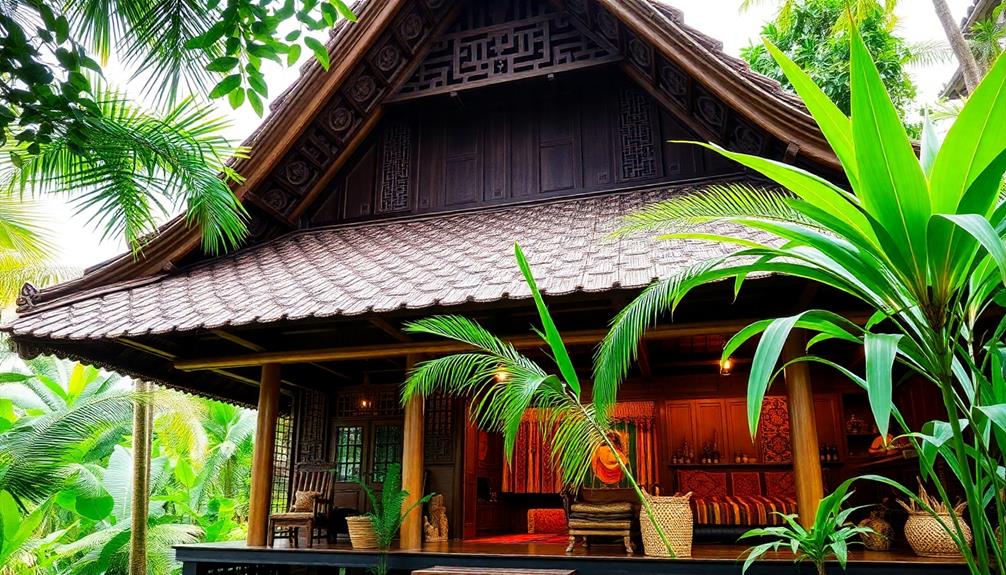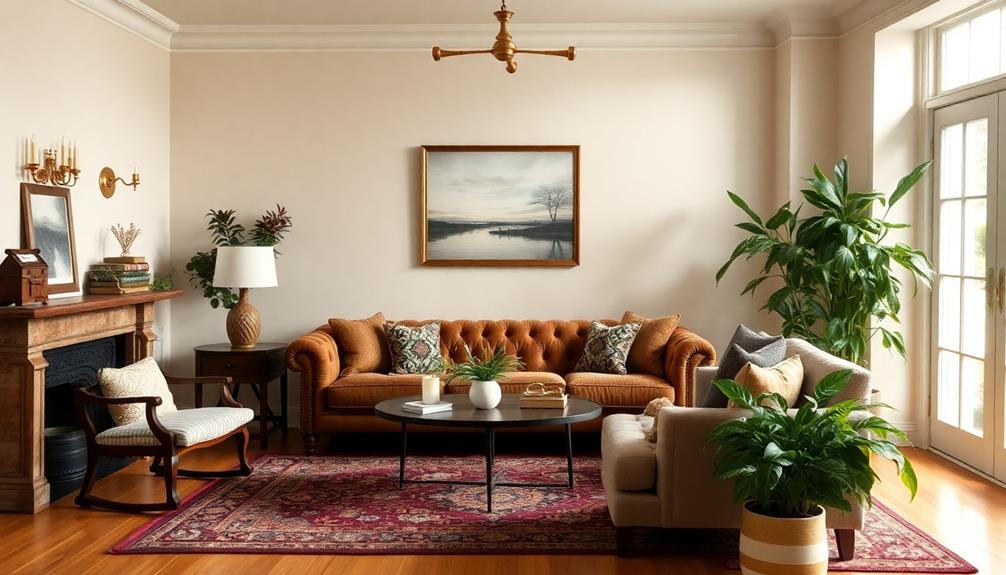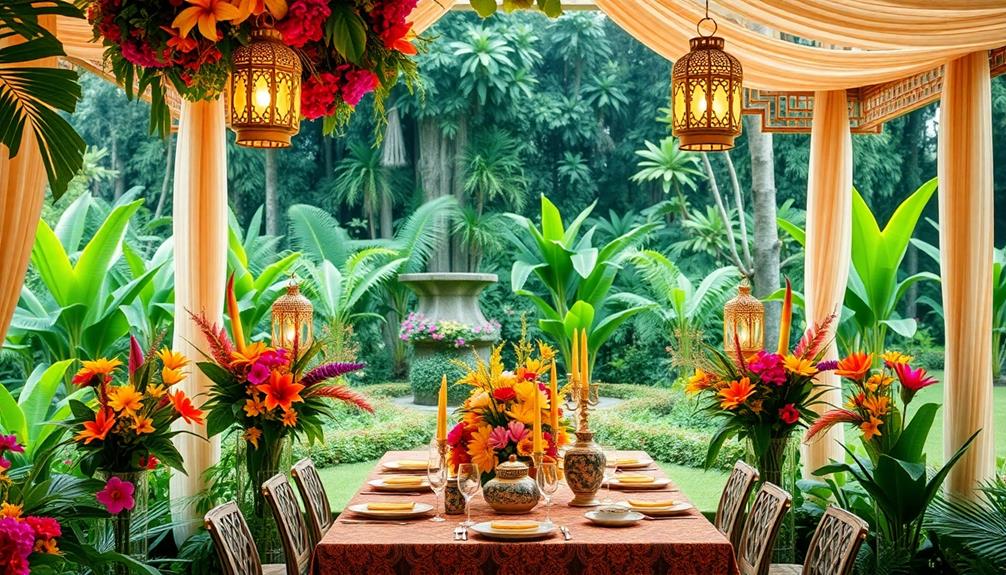A traditional Indonesian house is called "Rumah Adat." This term captures the country's rich cultural diversity and unique architectural styles across its many regions. You'll find variations like the Rumah Gadang with its steep roof or the Joglo House, favored by the Javanese elite. Each design reflects local customs, materials, and social hierarchies, serving as communal spaces that strengthen bonds within families and communities. These houses prioritize sustainability and resilience, too. Intrigued by the fascinating features and significance of these cultural icons? There's plenty more to discover about their architecture and the stories they hold! These traditional houses are not just buildings; they are living symbols of Indonesian culture and traditions. The intricate carvings, detailed artwork, and use of natural materials all reflect the values and beliefs that have been passed down through generations. As Indonesia continues to modernize, these houses serve as a reminder of the importance of preserving and honoring the rich heritage of the country. Exploring the architecture and history of Rumah Adat allows for a deeper understanding and appreciation of Indonesian culture and traditions.
Key Takeaways
- Traditional Indonesian houses are collectively known as "Rumah Adat," representing the nation's diverse cultural heritage and architecture.
- Each ethnic group has its own unique traditional house, such as Rumah Gadang, Joglo House, and Limas House.
- Architectural styles vary, with distinctive roof shapes and construction techniques reflecting local customs and natural resources.
- Traditional houses serve as communal spaces, promoting social ties and preserving cultural practices and traditions.
- Modern adaptations of Rumah Adat maintain cultural significance while incorporating contemporary design elements for current lifestyles.
Definition of Rumah Adat
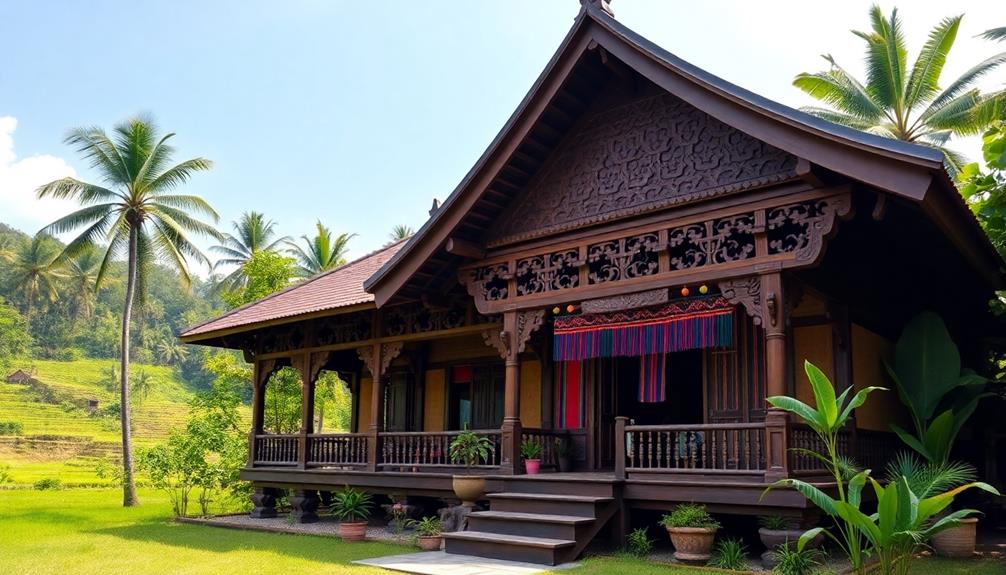
When you think about Indonesia's rich cultural diversity, "Rumah Adat" stands out as a fascinating representation of traditional architecture. These traditional houses embody the unique vernacular architecture of various ethnic groups across the archipelago. Each Rumah Adat is designed with a purpose, reflecting local customs, climate, and the natural materials available.
You'll notice distinct roof shapes, construction techniques, and decorative elements that tell a story about the community it represents. The interiors often feature stunning elements like Indonesian Decorative Pillows that enhance comfort and showcase cultural patterns.
For instance, the Rumah Gadang of the Minangkabau showcases a dramatic roof structure, while the Joglo House of Java highlights intricate carvings and spacious interiors. The Tongkonan of the Toraja is another stunning example, known for its boat-shaped roof and rich symbolism.
These houses aren't just structures; they're cultural heritage sites, emphasizing the importance of preserving the history and social relations of Indonesian communities.
Built primarily from wood, Rumah Adat is designed to withstand the tropical climate, featuring elevated platforms for ventilation and sharp roofs for efficient rainwater drainage.
Regional Variations of Traditional Houses
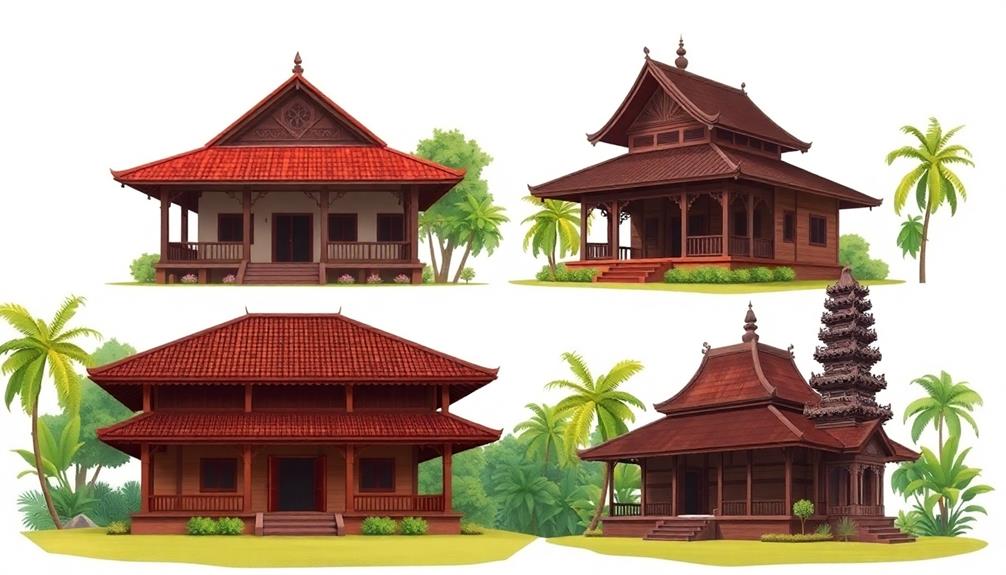
Exploring the diverse architectural styles of Rumah Adat reveals how regional variations reflect the unique cultural identities of Indonesia's ethnic groups. Each traditional house showcases distinct features in its architecture, often made from beautifully carved wooden materials.
For instance, the Rumah Gadang in West Sumatra is famous for its steeply pitched roof that resembles buffalo horns, serving as a communal space for family gatherings and reflecting the region's rich cultural symbolism.
In Central and East Java, the Joglo House stands out with its unique design supported by four main pillars, traditionally linked to Javanese nobility.
Meanwhile, the Limas House in South Sumatra boasts a tiered roof that resembles a pyramid, highlighting the Palembang region's intricate wood craftsmanship.
Over in Sulawesi, the Tongkonan House, with its boat-shaped roof, emphasizes ancestral worship and community gatherings through its elaborate carvings.
Finally, the Rumah Betang used by the Dayak tribes in Central Kalimantan is a longhouse elevated on stilts, designed for multiple families living together.
These variations in traditional homes not only reflect the local culture but also the practical needs of the communities.
Architectural Features and Techniques
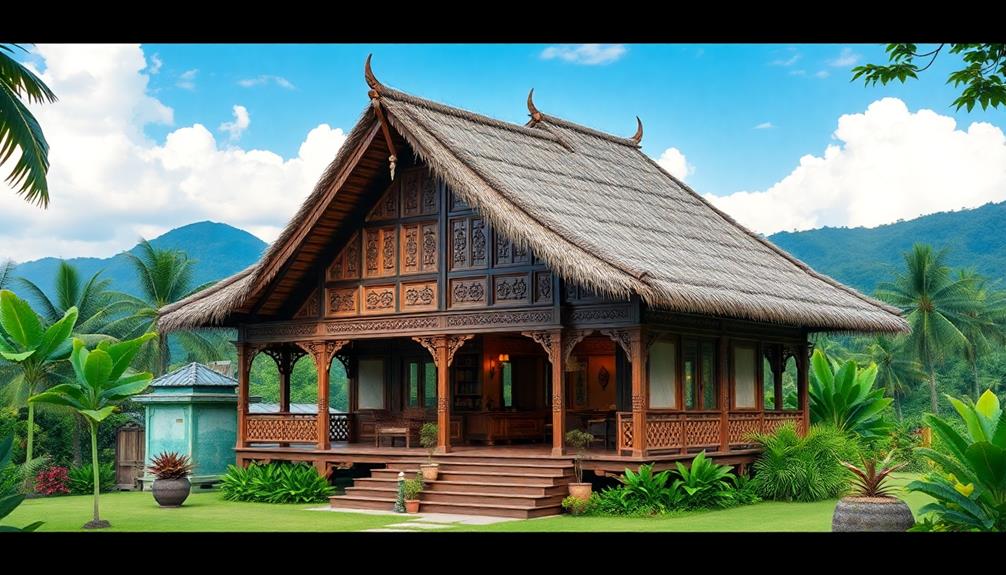
Traditional Indonesian houses showcase remarkable architectural features and techniques that reflect both environmental adaptability and cultural significance. Built primarily using locally sourced materials such as bamboo, wood, and thatch, these homes are designed to withstand the tropical climate, with elevated floors to protect against flooding and promote ventilation. The indonesian traditional home interiors often feature intricate wood carvings and woven textiles that reflect the region’s artistic heritage and spiritual beliefs. These handcrafted details not only enhance the aesthetic value of the home but also serve as symbols of identity and community.
Take the Rumah Gadang, for instance; its impressive curved roof resembles buffalo horns, offering not just aesthetic appeal but also functional benefits, like rainwater runoff. These houses are often elevated on large wooden stilts, promoting airflow and preventing flood damage, essential for the hot and wet monsoon climate.
This design is particularly important in regions prone to flooding, as it allows for better protection against water damage and pest invasions, aligning with the use of local materials characteristic of these homes.
Crafted from local materials like ironwood pillars and thatch material, these structures emphasize sustainability and craftsmanship. The architectural designs prioritize flexibility, ensuring that the wooden framework can withstand earthquakes, which makes them more resilient than modern concrete buildings in seismic zones.
Inside, you'll find layouts that reflect social hierarchies, with designated areas for family members and spaces for communal gatherings. This design fosters close-knit community relations, highlighting the importance of togetherness in traditional Indonesian life.
Cultural Significance and Community Role
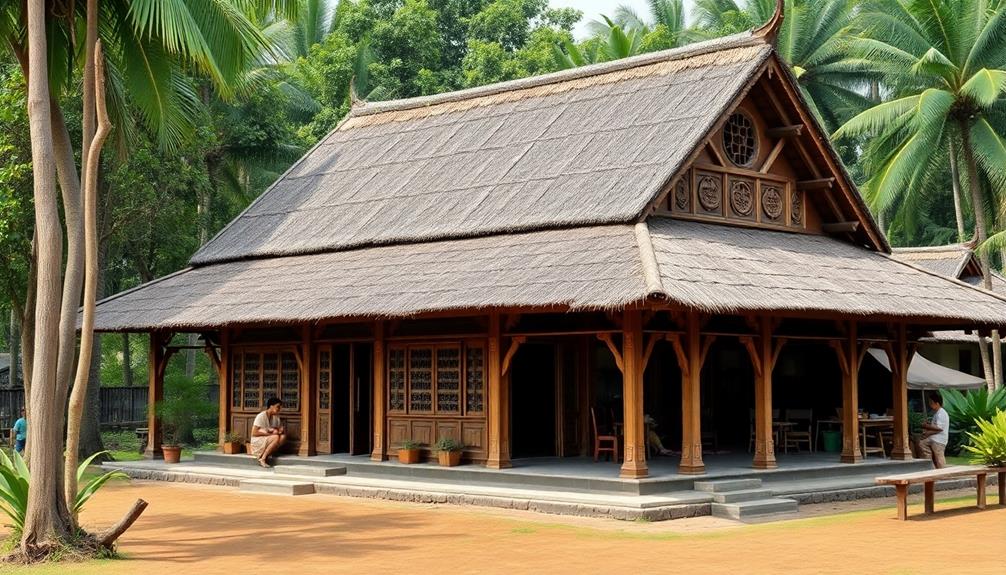
At the heart of Indonesian culture, traditional houses, or rumah adat, play an essential role in fostering community ties and preserving cultural identity. These houses serve as communal spaces, where families gather for various events, strengthening community bonds. For instance, the Rumah Gadang emphasizes matrilineal family dynamics, showcasing the significant role of women in inheritance and property matters.
Additionally, the Rumah Betang promotes unity among multiple families, highlighting the importance of collective responsibility.
Here's a brief overview of the cultural significance of traditional Indonesian houses:
| Aspect | Description |
|---|---|
| Communal Spaces | Gatherings for social events and family functions. |
| Family Dynamics | Reflects matrilineal structures and women's roles. |
| Cultural Ceremonies | Venues for rituals that preserve cultural heritage. |
| Architectural Designs | Influenced by local customs, symbolizing identity. |
These architectural designs not only provide shelter but also serve as important symbols of identity and continuity, ensuring that cultural practices and traditions are passed down through generations.
Modern Adaptations and Preservation Efforts
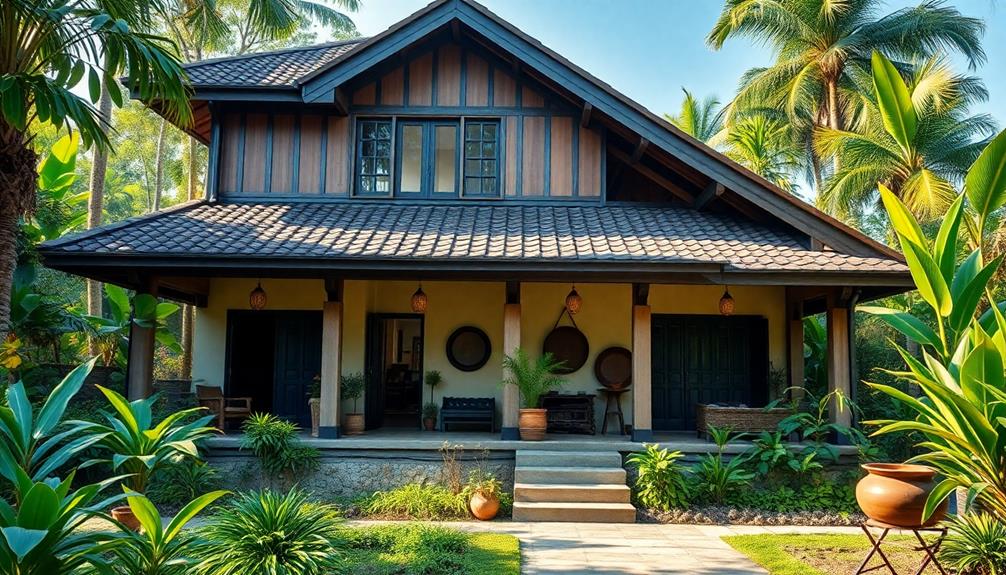
As Indonesia embraces modernity, traditional houses like the Rumah Gadang are evolving to fit contemporary lifestyles while still honoring their cultural roots.
You'll find that modern adaptations of these houses incorporate traditional features, melding them with innovative construction techniques. This fusion appeals to current societal preferences while preserving the essence of Indonesia's architectural heritage, often reflecting traditional Indonesian style home decor that emphasizes harmony with nature. Many modern adaptations also incorporate sustainable design principles, such as utilizing natural building materials and incorporating energy-efficient features. Additionally, homeowners can enhance the connection with nature and create a balanced living environment by applying feng shui tips for home, which are rooted in traditional Indonesian beliefs about the flow of energy through space and its impact on well-being. By integrating these elements, modern Indonesian houses can both honor the past and serve the needs of the present.
Preservation efforts are essential in this journey. Community initiatives play an important role, promoting cultural education and tourism, which helps sustain local economies.
By engaging locals and visitors alike, these programs foster a deeper appreciation for the Rumah Gadang and other traditional houses.
Furthermore, government initiatives and non-profit organizations are actively documenting and restoring these architectural treasures. This guarantees not only their longevity but also their relevance in our fast-paced world.
Architectural heritage sites like the Rumah Gadang now attract visitors and serve as venues for cultural events, showcasing Indonesia's rich history and diversity.
In this way, tradition and modernity coexist harmoniously, assuring that the legacy of the Rumah Gadang continues to thrive for generations to come.
Frequently Asked Questions
What Is a Traditional Indonesian House Called?
When you explore Indonesian culture, you'll discover that traditional houses, known as rumah adat, vary by region and ethnicity. Each style reflects unique architectural elements, showcasing the rich traditions and communal values of its people.
What Are the Indigenous Houses in Indonesia?
You'll discover a kaleidoscope of indigenous houses in Indonesia, each one a masterpiece! From the majestic Rumah Gadang to the enchanting Joglo, every structure bursts with culture, tradition, and stories waiting to be told.
What Type of Houses Do Indonesians Live In?
In Indonesia, you'll find various traditional houses, like the Rumah Gadang and Joglo. Each type reflects unique cultural values and regional influences, showcasing how architecture adapts to community needs and environmental conditions.
What Is the Traditional Indonesian House on Stilts?
The traditional Indonesian house on stilts is known for its elevated structure, designed to combat flooding and enhance airflow. You'll appreciate its unique design, often crafted from local materials, reflecting Indonesia's rich cultural heritage.
Conclusion
In summary, the Rumah Adat stands as a tribute to Indonesia's rich cultural heritage, showcasing regional diversity and architectural prowess. While some may theorize that modernization threatens these traditional homes, many communities are embracing innovations that respect their roots. By blending old and new, they guarantee that the essence of the Rumah Adat endures. So, whether you're exploring its ornate features or participating in community events, you're engaging with a living symbol of Indonesia's identity.
